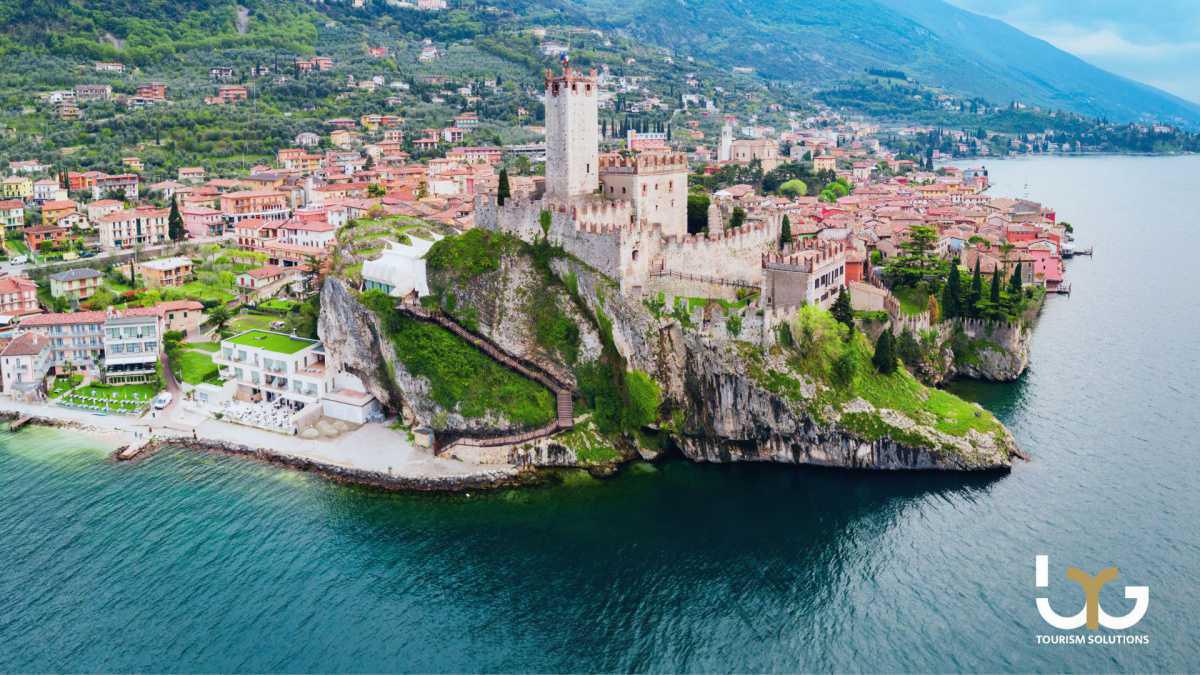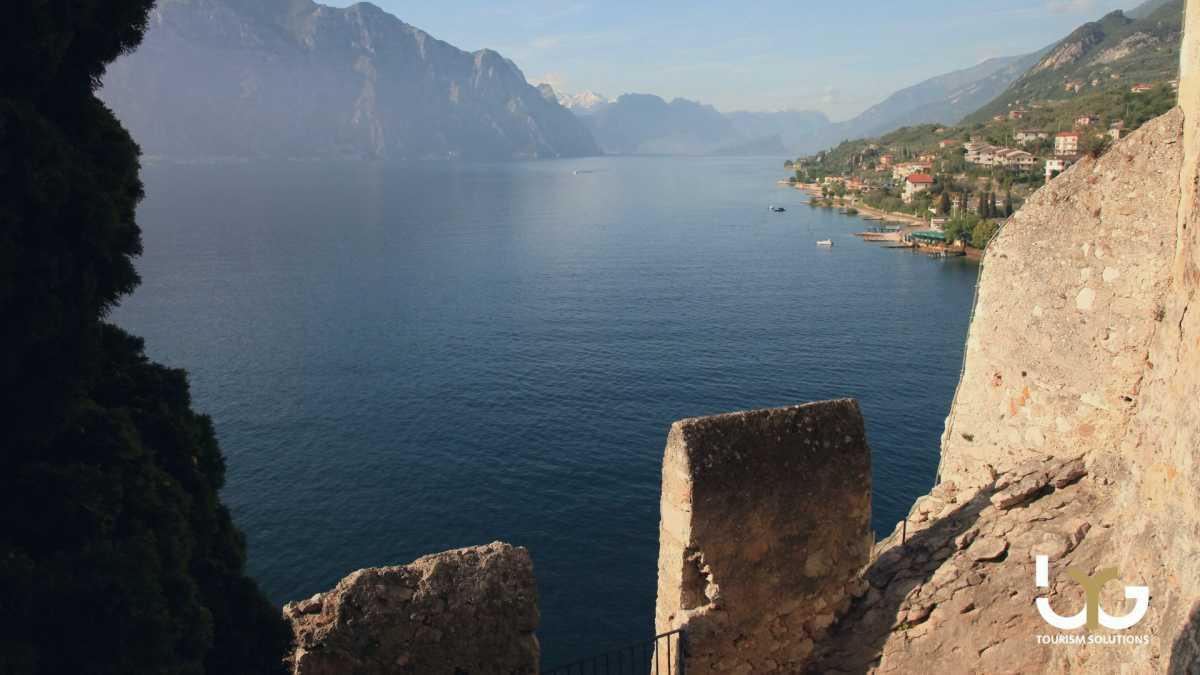
Castello Scaligero di Malcesine
Via Castello Malcesine Malcesine
IT EN DE
Il Castello Scaligero, simbolo di Malcesine, ha origini antiche, risalenti probabilmente al primo millennio a.C., ma è attestato che sia stato costruito dai Longobardi circa nella metà del primo millennio d.C. Dopo essere stato distrutto dai Franchi nel 590, fu ricostruito e ospitò il re Pipino nel 806 durante la visita ai Ss. Benigno e Caro. Successivamente, passò sotto il dominio dei feudi vescovili veronesi e nel 1277 divenne possedimento della famiglia della Scala, mantenendosi sotto il casato fino al 1387. Durante questo periodo, il castello prese il nome attuale di "Castello Scaligero". Fu occupato dai Visconti di Milano dal 1387 al 1403, poi dalla Repubblica di Venezia dal 1405 al 1506, quando l'Impero lo riconquistò. Successivamente, tornò sotto il dominio della Repubblica fino al 1797, passando poi ai Francesi. Gli Austriaci presero possesso del castello nel 1798 e vi eseguirono lavori di consolidamento fino al 1866. Nel 1902 fu dichiarato Monumento Nazionale.
Il castello offre una ricca esperienza di visita. Nel cortile si trova la "Casermetta", che ospita il Museo di storia naturale al piano terra e al piano interrato. Una scala esterna conduce a una sala per esposizioni e matrimoni. Il museo offre un approccio multimediale, permettendo ai visitatori di interagire con gli oggetti e di sperimentare il paesaggio circostante attraverso le finestre.
Dal cortile si può accedere a un poggiolo che si affaccia sul lago, offrendo una vista panoramica suggestiva. Una rampa conduce alla "Sala Goethe", dove sono esposte le immagini tratte dal viaggio in Italia dello scrittore. Sul "Rivellino" vengono celebrati i matrimoni civili. Sul muro orientale si trovano resti di affreschi e uno spazio chiamato "Lacaòr", utilizzato come teatro all'aperto durante l'estate.
Il terzo cortile, il più alto, è raggiungibile tramite una rampa e un portale scaligero. Qui si trova un pozzo e un affresco raffigurante una Madonna con Bambino. Una scala conduce alla Sala Congressi e alla Torre. La Sala Congressi ospita mostre e convegni, mentre la Torre offre una vista panoramica su Malcesine e sul lago, oltre ad avere una storia che risale al 1131.
La Torre, con la sua forma pentagonale irregolare, si erge per 70 metri sopra il lago, con una base alta 31 metri.
IT EN DE
The Scaliger Castle, symbol of Malcesine, has ancient origins, probably dating back to the first millennium BC, but it is attested that it was built by the Lombards around the middle of the first millennium AD. After being destroyed by the Franks in 590, it was rebuilt and hosted King Pepin in 806 during his visit to Saints Benigno and Caro. Subsequently, it came under the domain of the Veronese episcopal fiefs, and in 1277 it became the possession of the della Scala family, remaining under their house until 1387. During this period, the castle took on the current name of "Scaliger Castle". It was occupied by the Visconti of Milan from 1387 to 1403, then by the Republic of Venice from 1405 to 1506, when the Empire reconquered it. Later, it returned under the dominion of the Republic until 1797, passing then to the French. The Austrians took possession of the castle in 1798 and carried out consolidation works there until 1866. In 1902, it was declared a National Monument.
The castle offers a rich visiting experience. In the courtyard is the "Casermetta", housing the Natural History Museum on the ground floor and basement. An external staircase leads to a room for exhibitions and weddings. The museum offers a multimedia approach, allowing visitors to interact with objects and experience the surrounding landscape through the windows.
From the courtyard, you can access a balcony overlooking the lake, offering a suggestive panoramic view. A ramp leads to the "Goethe Hall", where images from the writer's journey to Italy are displayed. Civil weddings are celebrated on the "Rivellino". On the eastern wall are remnants of frescoes and a space called "Lacaòr", used as an open-air theater during the summer.
The third courtyard, the highest, is reachable via a ramp and a Scaliger portal. Here there is a well and a fresco depicting a Madonna with Child. A staircase leads to the Congress Hall and the Tower. The Congress Hall hosts exhibitions and conferences, while the Tower offers a panoramic view of Malcesine and the lake, as well as having a history dating back to 1131.
The Tower, with its irregular pentagonal shape, rises 70 meters above the lake, with a base height of 31 meters.
IT EN DE
Das Scaliger Schloss, Symbol von Malcesine, hat antike Ursprünge, die wahrscheinlich bis ins erste Jahrtausend v. Chr. zurückreichen, aber es ist belegt, dass es von den Langobarden um die Mitte des ersten Jahrtausends n. Chr. erbaut wurde. Nachdem es im Jahr 590 von den Franken zerstört wurde, wurde es wiederaufgebaut und beherbergte König Pipin im Jahr 806 während seines Besuchs bei den Heiligen Benigno und Caro. Anschließend kam es unter die Herrschaft der Veroneser bischöflichen Lehen, und im Jahr 1277 wurde es zum Besitz der Familie della Scala, blieb bis 1387 unter ihrem Haus. Während dieser Zeit erhielt die Burg den heutigen Namen "Scaliger Schloss". Sie wurde von den Visconti von Mailand von 1387 bis 1403 besetzt, dann von der Republik Venedig von 1405 bis 1506, als das Reich es zurückeroberte. Später kehrte sie unter die Herrschaft der Republik zurück bis 1797, ging dann an die Franzosen über. Die Österreicher übernahmen die Burg im Jahr 1798 und führten dort bis 1866 Konsolidierungsarbeiten durch. Im Jahr 1902 wurde sie zum Nationaldenkmal erklärt.
Das Schloss bietet ein reiches Besuchererlebnis. Im Hof befindet sich die "Casermetta", die das Naturhistorische Museum im Erdgeschoss und im Untergeschoss beherbergt. Eine externe Treppe führt zu einem Raum für Ausstellungen und Hochzeiten. Das Museum bietet einen multimedialen Ansatz, der es den Besuchern ermöglicht, mit Objekten zu interagieren und die umliegende Landschaft durch die Fenster zu erleben.
Vom Hof aus gelangt man zu einem Balkon mit Blick auf den See, der einen eindrucksvollen Panoramablick bietet. Eine Rampe führt zur "Goethe Halle", wo Bilder von der Reise des Schriftstellers nach Italien ausgestellt sind. Zivile Hochzeiten werden im "Rivellino" gefeiert. An der östlichen Wand befinden sich Reste von Fresken und ein Raum namens "Lacaòr", der im Sommer als Freilufttheater genutzt wird.
Der dritte Hof, der höchste, ist über eine Rampe und ein Scaliger Portal erreichbar. Hier befindet sich ein Brunnen und ein Fresko, das eine Madonna mit Kind darstellt. Eine Treppe führt zum Kongresssaal und zum Turm. Der Kongresssaal beherbergt Ausstellungen und Konferenzen, während der Turm einen Panoramablick auf Malcesine und den See bietet und eine Geschichte hat, die bis ins Jahr 1131 zurückreicht.
Der Turm, mit seiner unregelmäßigen pentagonalen Form, erhebt sich 70 Meter über dem See, mit einer Basis von 31 Metern Höhe.

